Good luck finding two peppers that are more dissimilar than poblanos and habaneros!
Poblano peppers are between 1,000-2,000 Scoville Heat Units (SHU) and are nowhere near as spicy as habaneros which range from 100,000-350,000 SHU. Poblanos are much larger and have a rich, smoky flavor. Habaneros are smaller with wrinkled skin and a bright citrus-floral flavor. The only thing they have in common is that they are high in vitamin C!
Read on to learn about the differences between these two distinct peppers!
Comparison – differences between poblano peppers and habanero peppers
Let’s do a thorough walkthrough and break down the exact differences between these peppers.
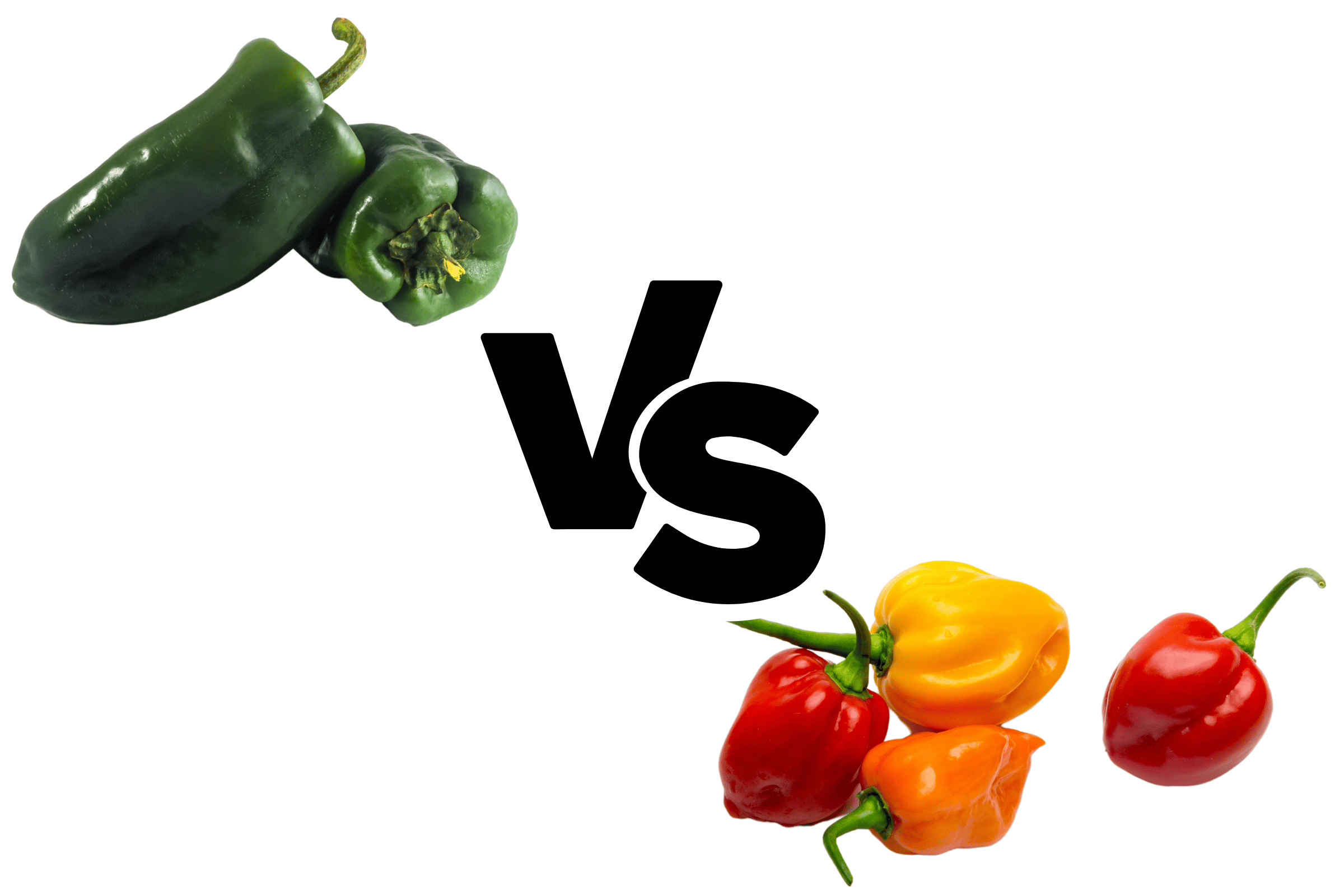
Let’s look at the similarities and differences between poblano and habanero peppers based on the following criteria:
- Poblano pepper vs habanero heat level
- Poblano pepper vs habanero flavor
- Poblano pepper vs habanero texture
- Poblano pepper vs habanero size and shape
- Poblano pepper vs habanero nutrition
- Poblano pepper vs habanero cost and availability
- Unique difficulties
- Substitutions
| Criteria | Poblano Pepper | Habanero Pepper |
|---|---|---|
| Heat level | 1,000-2,000 SHU | 100,000-350,000 |
| Flavor | Deep, dark, smoky | Bright, citric, spicy |
| Texture | Smooth | Wrinkly |
| Size | up to 6″ | about 2.5″ |
| Shape | Relatively flat | Pointy cones |
| Nutrition (per 100g) | 20 Calories 134% DV Vitamin C | 40 Calories 240% DV Vitamin C |
| Substitutions | Bell peppers | Scotch Bonnet peppers |
Poblano pepper vs habanero heat level (in Scoville heat units)
If you’re interested in peppers, you’re probably wondering about their heat level – whether to find the hottest one you can or to find one that gives great flavor and a pleasant tingle without the burn.
Poblano peppers range from 1,000-2,000 SHU. Meanwhile, habaneros are considered very spicy with an SHU of 100,000-350,000.
The hottest habanero is 350 times as hot as the mildest poblano!
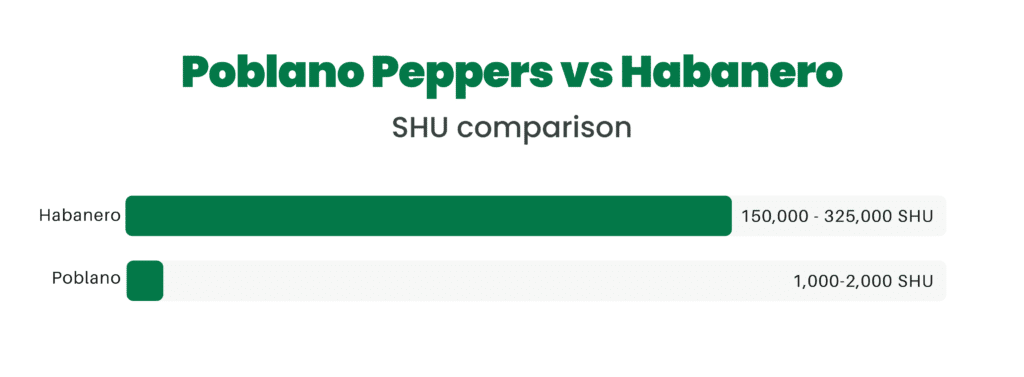
Poblano pepper vs habanero flavor
The flavors of poblanos and habaneros couldn’t be any more different even if they tried.
Poblanos are deep, dark, rich, and earthy with an essence of spice. Habaneros are bright, floral, and citrusy with an intense hot kick.
The best pepper to use in your recipe will depend on many factors, but the flavor is definitely an important one!
Poblano pepper vs habanero texture
As you might be able to guess from their often widely different uses, poblano peppers and habaneros have as little in common texturally as they do in other categories.
Both peppers are visually different – poblanos are very smooth, while habaneros are incredibly wrinkled – but the differences don’t stop there. Poblanos have a thick, papery skin that should be removed before eating.
Habenero skins only need to be removed if your recipe calls for a particularly tender pepper.
Poblano pepper vs habanero size and shape
Poblanos are relatively flat and reach up to 6 inches long.
Habaneros are pointy cones that only get to be 2 ½ inches long.
Poblano pepper vs habanero nutrition
While they aren’t often used interchangeably in recipes, both poblanos and habaneros offer comparable nutritional benefits.
Both poblanos and habaneros are low in calories and can provide over 100% of your DV of Vitamin C.
Vitamin C is a powerful antioxidant that battles against free radicals. It also helps make collagen. In addition, it helps control infections and heal wounds.
Poblano pepper vs habanero cost and availability
Habaneros are harder to come by than poblanos, and therefore cost more because the demand is higher than the supply.
This may be different in countries where habaneros are used more regularly.
Unique difficulties
One unique difficulty of cooking with poblanos is their tough outer skin. Many people like to remove the skin.
The biggest challenge when cooking with habaneros is staying safe. They have such a high SHU rating that you really need to be careful about wearing gloves and avoiding touching your eyes. A habanero at the upper end of its range can actually burn your skin!
Can you substitute poblano peppers for habanero peppers or vice versa?
I guess technically you can substitute any ingredient for another. My father once made pizza with ketchup on it! But here’s the thing – it wasn’t good.
You shouldn’t substitute poblano peppers for habanero peppers. They have extremely different profiles and habaneros are 50 times hotter at the very least!
Even if you choose to make this substitution, there’s really no way that the resulting meal could be considered the same dish.
Poblano peppers – a complete overview
Poblano peppers are a mildly spicy pepper from Puebla, Mexico. They’re often grilled or roasted and are a favorite among gardeners because they’re relatively easy to grow, yield a bountiful harvest, and are just plain delicious.
Time to outline the characteristics of poblanos!
Heat
Poblano peppers have a Scoville Heat Unit rating ranging from 1,000 to 2,000. This puts them in the category of mild spicy peppers.
Fully mature poblanos are a deep red and about twice as spicy as the shiny dark green ones you’re probably used to seeing in the grocery store.
The spiciness of your poblano depends on how mature it is. Capsaicin, the “spice compound”, increases within peppers as they mature.
Flavor
Poblanos are often considered a step up from bell peppers with no heat, but they have vastly different flavor profiles.
A poblano pepper’s flavor is earthy, full, and grounded. Roasting them mellows them out.
They also have some umami to them.
Size, shape, and texture
Immature poblano peppers are about 4 inches long and mature poblanos are about 6 inches long.
The shape of poblano peppers can be described as a flattened bell pepper, although they come to a slight point toward the bottom that isn’t characteristic of the other.
Poblanos are juicy with a tough skin.
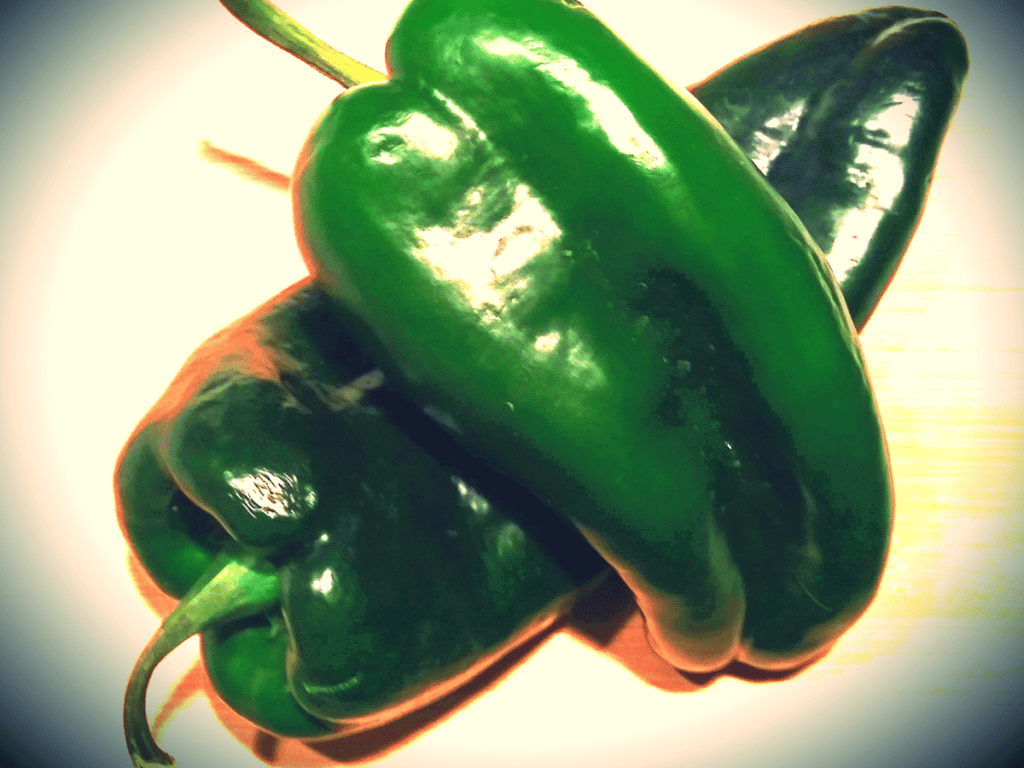
Nutritional content and potential health benefits
Some of the potential health benefits of poblano peppers include:
- Full of antioxidants
- Fights inflammation
- Boosts immune system
Some notable nutritional facts about poblano peppers are that 100g (raw) has:
- 20 calories
- 134% DV Vitamin C
- 17% DV Vitamin B6
- 6.2% DV dietary fiber
Cooking with poblano peppers
Poblano peppers are much-loved, especially in Mexican-inspired cuisines, for their deep flavor and mild spiciness. Unless you don’t want any spice at all, you can probably handle the heat from a poblano.
Most often sauteed (especially with onions), grilled, or roasted, poblano peppers are also excellent for stuffing because their skin and thick walls are sturdy enough to hold the weight and moisture of a whole meal.
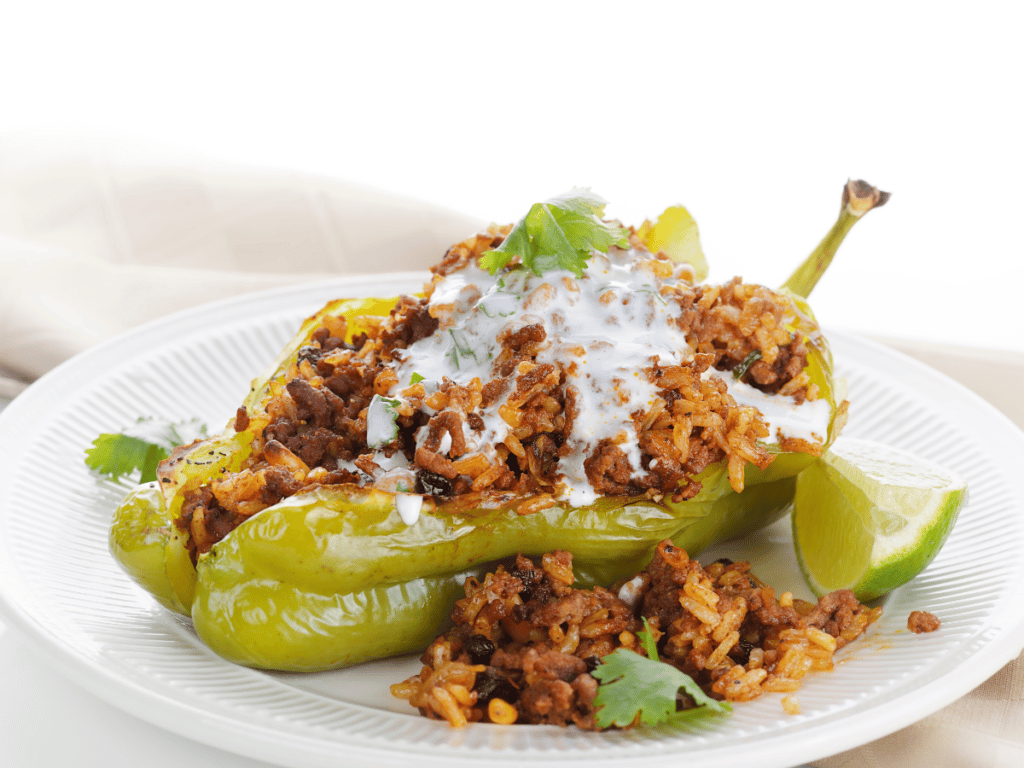
Blistering poblano peppers brings out their deepest flavors and is sure to be a fan favorite.
While some people may eat poblanos raw, their toughness is usually a deterrent.
Substitutions for poblano peppers
Bell peppers are a useful substitute for poblanos if you’re in a pinch, but they won’t come close to the earthiness or depth of flavor.
And of course, they won’t be spicy!
Freezing, drying, and preserving poblano peppers
You can easily freeze, dry, and pickle poblanos.
Poblano peppers are a great candidate for storage as long as you do it correctly.
Habanero peppers – a complete overview
Habanero peppers are popular in salsas and hot sauces, but you’re less likely to find these tropical, slightly fruity peppers in common recipes because of their heat.
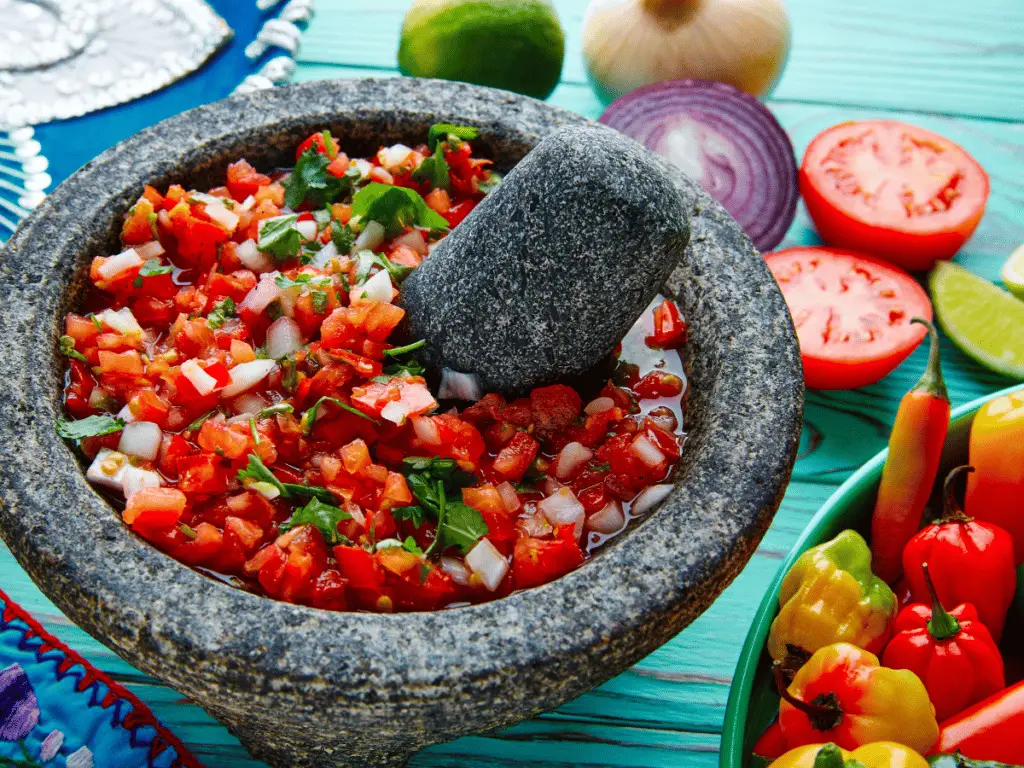
If you think you’re up for it, let’s take a look at everything the small – but mighty – habanero has to offer!
Heat
Habaneros are a very spicy pepper ranging from 100,000 to 350,000 SHU.
If you’re not comfortable with some serious heat, habaneros aren’t for you, although they’re by no means the hottest pepper around!
The hottest habanero peppers actually have enough capsaicin to burn your skin if handled incorrectly.
Flavor
Habaneros have a unique floral and citrusy taste, which is definitely unexpected from such a hot pepper. So long as you can handle the heat, you’re in for a flavorful treat!
Size, shape, and texture
Habaneros are about an inch to 2 ½ inches long.
Their shapes vary but are comparable to mini bell peppers with a pointed tip.

Habaneros have a wrinkled texture.
Nutritional content and potential health benefits
Potential health benefits of habanero peppers include:
- Antioxidants (Vitamin C)
- Anti-inflammatory (capsaicin)
- Good for eye health (carotenoids)
Some notable nutritional contents of habenero peppers are they contain the following per 100g (raw):
- 40 calories
- 240% DV Vitamin C
- 20% DV Vitamin A
Cooking with habanero peppers
Habanero peppers are often de-seeded and sauteed until they’ve softened.
Once seasoned, you can add them to Mexican dishes like quesadillas, fajitas, tacos, or burritos.
You can also make chili powder by dehydrating them.
If you’re feeling adventurous, making your own hot sauce is fun and rewarding!
Be EXTRA CAREFUL when handling habaneros. Wear gloves and avoid touching your eyes under any circumstance!
Substitutions for habanero peppers
If you can’t get your hands on a habanero pepper, what do you?
The Scotch Bonnet has an SHU rating of 100,000-350,000 and floral undertones, so it is identical in heat and similar in flavor to habaneros.
That being said, habaneros are much easier to find so it’s unlikely that you’ll have to make this substitution. It’s something to keep in mind when you’re planning your pepper garden though!
Freezing, drying, and preserving habanero peppers
You preserve habaneros the same way you would any other hot pepper.
Some options include pickling, canning, freezing, and drying.

